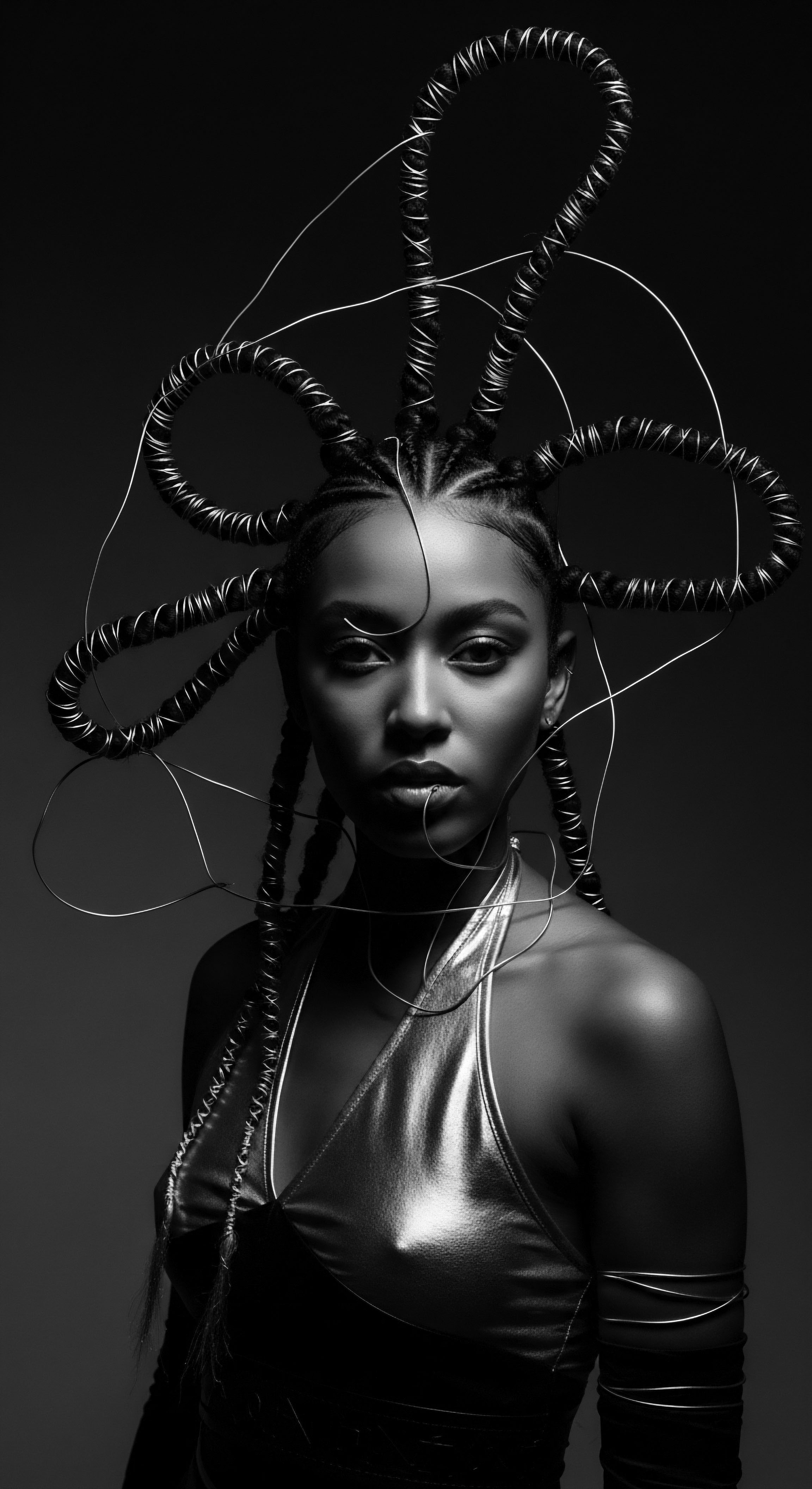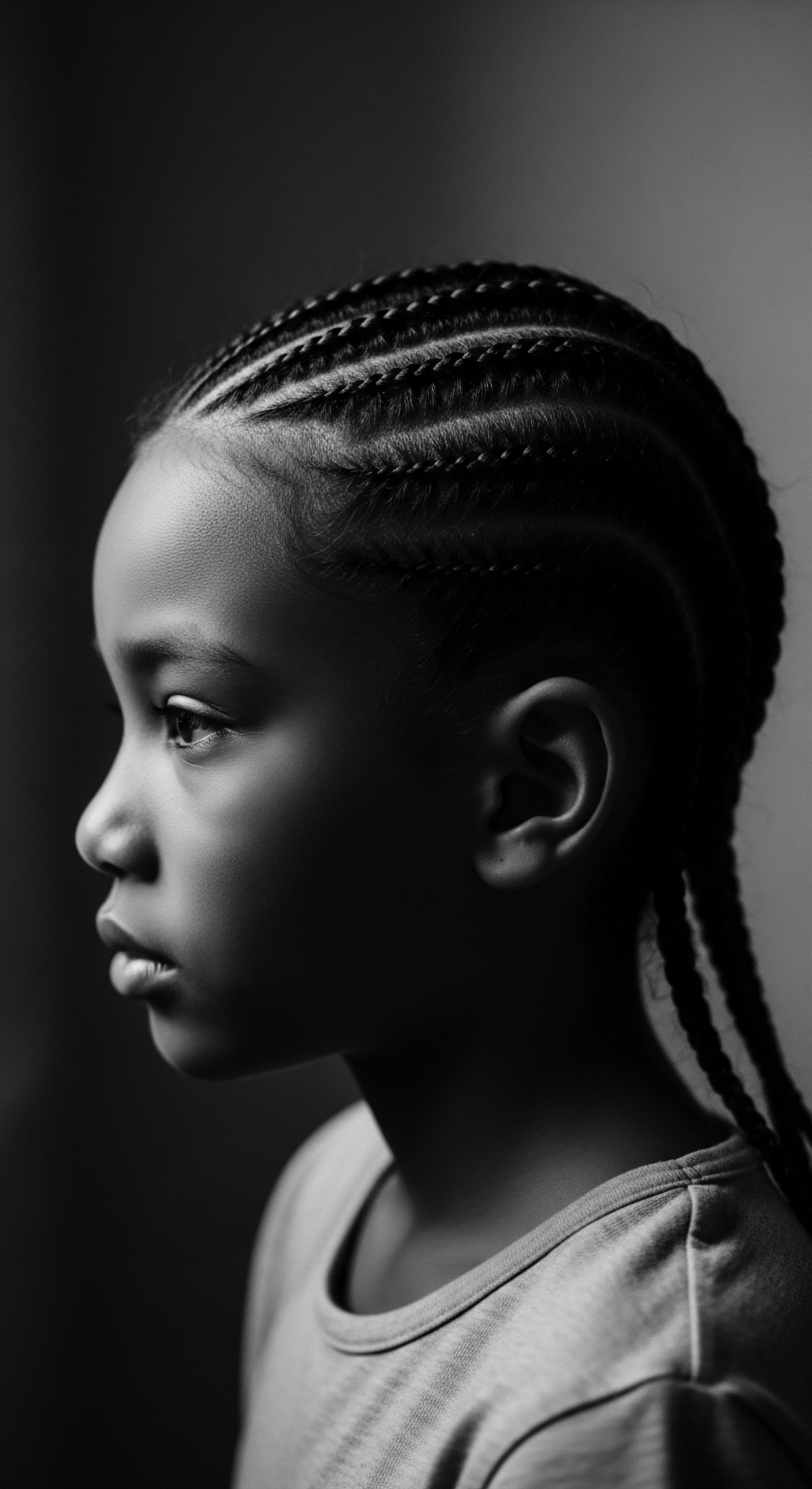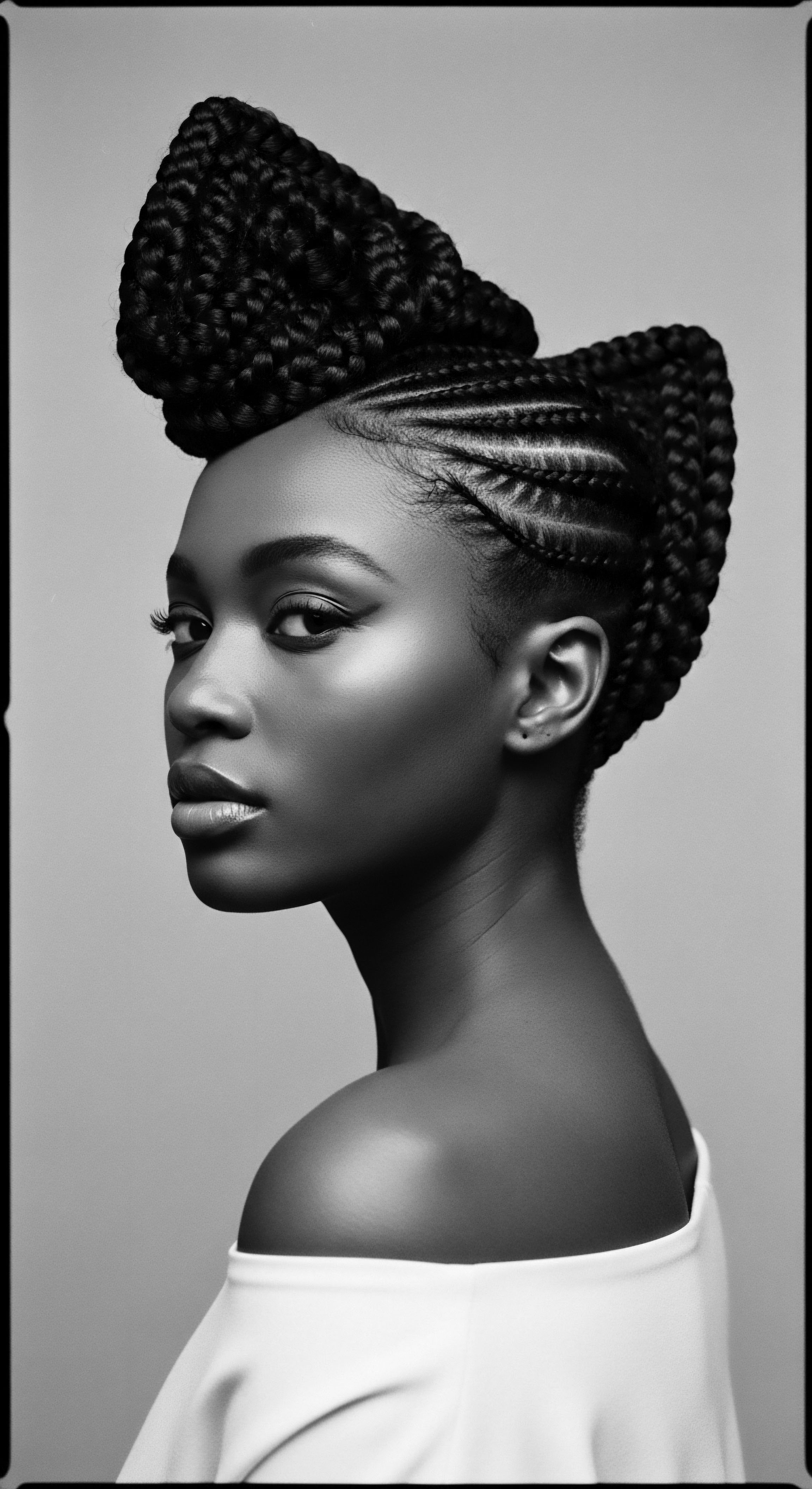
Roots
Imagine a time when the very fiber of one’s being was interwoven with the strands atop their head. A time when hair, in its glorious textured forms, served as a living archive, a narrative of lineage, status, and spirit. For generations, before the advent of modern conveniences, ancestral communities across the African continent and its diaspora honed ingenious methods to safeguard their crowns, ensuring their vitality through the quiet hours of night. The question of how ancestral braiding traditions preserved textured hair overnight isn’t simply a matter of historical curiosity; it is a profound journey into the ingenuity, resilience, and deep reverence for hair that defined these cultures.
These practices, born from necessity and refined over centuries, reveal an intuitive understanding of hair biology—a wisdom passed down through the gentle touch of a grandmother’s hands, the rhythmic click of braiding needles, or the shared laughter during communal styling sessions. The hair strand, far from being inert, is a dynamic structure, susceptible to external forces. Ancestral traditions, therefore, developed methods that minimized mechanical stress and moisture loss, two primary antagonists of healthy textured hair. The brilliance lay in their holistic approach, viewing hair not in isolation but as an integral part of the body, spirit, and community.

The Textured Hair Codex ❉ Foundations and Anatomy
To truly appreciate the genius of ancestral overnight preservation techniques, one must first understand the unique architecture of textured hair. Unlike straight or wavy hair, textured strands possess a distinct elliptical cross-section, with a cortex that is often more varied in its cellular arrangement. This unique structure, coupled with its propensity to coil, results in fewer cuticle layers lying flat, making it naturally more susceptible to dryness and breakage. The journey of understanding ancestral braiding traditions begins with this elemental biology, an echo from the source itself.
Traditional practitioners, without the benefit of microscopes, observed these fundamental characteristics through lived experience. They understood the hair’s thirst, its fragility, and its need for careful handling. This intuitive understanding informed their choice of tools, ingredients, and most importantly, their styling methods.
They recognized that the very shape of the hair made it prone to tangling and knotting, especially when exposed to friction during sleep. Braids, twists, and various forms of coiling offered an immediate, practical solution to this inherent vulnerability.
Ancestral braiding traditions reveal an intuitive, heritage-deep understanding of textured hair’s unique biology and its inherent needs for protection.

Ancestral Lexicon of Strand Care
The language used to describe textured hair and its care rituals within ancestral communities was not merely functional; it was imbued with cultural significance. Terms for different braid patterns, tools, and plant-based concoctions reflected a deep, shared knowledge system. While modern classification systems for hair texture often focus on curl pattern (e.g. 3C, 4A), ancestral understanding was perhaps more qualitative, tied to the hair’s responsiveness, its “thirst,” and its ability to hold a style.
Consider, for instance, the various names given to specific braiding patterns across different West African cultures—names that often described the pattern’s resemblance to agricultural fields, animal tracks, or sacred symbols. These names conveyed not only the aesthetic but also the protective function of the style, implicitly referencing its durability and ability to keep the hair contained and cared for, even through the night. The very act of naming these styles became a way to codify and transmit centuries of collective wisdom.
- Adunni ❉ A Yoruba term, sometimes referring to a person whose very presence brings sweetness, reflecting the desired soft and well-maintained texture of hair.
- Knotless Braids ❉ While a modern term, its protective principles mirror ancestral designs that minimized tension on the scalp and hair follicles.
- Cowrie Shell Embellishments ❉ Beyond decoration, these often signified status or spirituality, and their placement within braids required a stable, enduring style that could withstand daily life, including sleep.

Cycles of Growth and Ancestral Wisdom
The human hair growth cycle—anagen (growth), catagen (transition), and telogen (resting)—was, of course, unknown in its precise scientific terms to ancestral communities. However, their practices demonstrated a profound awareness of its effects. They recognized periods of shedding, the need for growth encouragement, and the importance of allowing hair to rest and recover. Protective styles like braids, especially those maintained for extended periods, directly supported these natural cycles.
By containing the hair, braids reduced external manipulation, which in turn minimized breakage, allowing more strands to remain in the anagen phase longer. This meant sustained growth and healthier hair overall. The overnight preservation of these styles was critical in extending their longevity and thus amplifying their protective benefits throughout the hair’s natural growth progression. This holistic approach, integrating styling with the hair’s inherent life cycle, reveals a sophisticated understanding of hair health, deeply rooted in ancestral observation and practice.

Ritual
The act of braiding textured hair, particularly in ancestral contexts, transcended mere beautification; it was a ritual. Each partition, each twist, each interwoven strand carried generations of wisdom, a silent conversation between past and present. These rituals, performed often communally under the glow of firelight or the morning sun, were the bedrock of hair preservation, preparing the crown for the rigors of the day and, most importantly, the vulnerabilities of the night.
How did ancestral braiding traditions specifically prepare and preserve textured hair overnight? The answer lies in the meticulous techniques, the purpose-built tools, and the deep cultural significance assigned to these nocturnal practices.
Overnight preservation was not an afterthought; it was an intrinsic component of the braiding tradition itself. The longevity of intricate styles, some taking hours or even days to construct, hinged upon their ability to withstand the tossing and turning of sleep. Losing a week’s worth of meticulous work to friction or tangling was simply not an option. Thus, techniques were developed to encapsulate the hair, minimize movement, and provide a protective barrier against environmental aggressors, even those encountered on a sleeping mat or bed of leaves.

The Sacred Geometry of Protective Styles
Ancestral protective styles were masterclasses in functional design. Braids, twists, and coils, in their myriad forms, served as natural encapsulations for the hair strands. When hair is left loose, particularly textured hair, it is prone to friction against fabrics, leading to raised cuticles, moisture loss, and eventual breakage. By organizing the hair into compact, interwoven units, ancestral braiders inherently minimized this friction.
For overnight preservation, the goal was twofold ❉ to maintain the integrity of the style itself and to safeguard the hair within it. This often involved creating smaller, tighter braids or twists that would then be gathered, pinned, or wrapped into a larger, more secure configuration. Think of it as a layered defense system.
The individual braids provided internal protection, while the overarching style offered external fortification against the rigors of sleep. This foresight, a testament to deep ancestral knowledge, ensured that hours of labor were not undone by a single night.
Overnight preservation was an integral part of ancestral braiding, ensuring the longevity of intricate styles and the protection of precious strands.

Tools Shaped by Tradition
The tools used in ancestral hair care were as thoughtfully crafted as the styles themselves. While modern society relies on an array of plastic combs and synthetic materials, ancestral communities utilized what nature provided, shaping wood, bone, and natural fibers into implements that honored the hair.
Consider the finely carved wooden combs, often adorned with symbols, that were used to detangle and section hair. Their wide teeth, unlike fine-toothed combs, gently separated coils, reducing snagging and breakage. For overnight care, these combs were often used for careful detangling before braiding, ensuring a smooth foundation for the protective style. Beyond combs, the hands themselves were perhaps the most significant tools, skilled and practiced in the art of sectioning, twisting, and interlacing.
The development of headwraps, caps, and bonnets, fashioned from various plant fibers or animal skins, also played a central role in overnight hair preservation. These coverings served as a soft, breathable barrier between the hair and the sleeping surface. They helped to retain moisture, prevent friction, and keep intricate styles intact, preventing the need for re-styling every morning.
| Implement/Method Wooden Combs |
| Description Wide-toothed, often hand-carved, used for gentle detangling. |
| Overnight Preservation Link Minimized breakage before braiding, creating a smooth foundation for long-lasting protective styles that endured sleep. |
| Implement/Method Natural Oils/Butters |
| Description Derived from plants like shea, coconut, or moringa; applied for moisture and conditioning. |
| Overnight Preservation Link Sealed moisture into braided hair, preventing dryness and brittleness overnight, aiding flexibility. |
| Implement/Method Headwraps/Covers |
| Description Fabric or natural material coverings for the head. |
| Overnight Preservation Link Reduced friction against sleeping surfaces, kept braids tidy, and retained moisture, allowing styles to last for days or weeks. |
| Implement/Method Communal Braiding |
| Description Social gatherings where hair was styled collectively. |
| Overnight Preservation Link Ensured consistent, skilled application of protective styles designed to last, reinforcing techniques for optimal preservation. |
| Implement/Method These ancestral tools and communal practices were interwoven with the daily rhythm of life, prioritizing hair health and style longevity through the night. |

Weaving Identity Through Braids
Braiding, beyond its practical applications, was a profound act of cultural expression and identity. In many African societies, a person’s hairstyle communicated their age, marital status, tribal affiliation, and even their spiritual beliefs. The very duration and complexity of these styles underscored their significance; they were not meant to be fleeting. The desire to preserve these markers of identity naturally extended to overnight care.
For example, the intricate hairstyles of the Fulani women of West Africa , often adorned with cowrie shells and amber beads woven into finely braided sections, were not only beautiful but durable. These styles could be worn for weeks, requiring careful nighttime maintenance to ensure their integrity. The cultural value placed on such elaborate coiffures meant that their preservation, even during sleep, was paramount.
This practical consideration—how to extend the life of a culturally significant, labor-intensive style—directly drove the development of effective overnight hair care. The deep respect for personal and communal identity, often expressed through hair, underscored the commitment to its proper preservation.

Relay
The legacy of ancestral braiding traditions, particularly concerning overnight preservation, continues to resonate in contemporary textured hair care. This relay of wisdom, from ancient practices to modern understanding, shows how deep-seated heritage informs current scientific insights. How did ancestral braiding traditions preserve textured hair overnight, and what can modern science tell us about the efficacy of these time-honored methods? The answer lies in the confluence of intuitive wisdom and empirical validation, allowing a deeper appreciation for the ingenuity embedded within these historical practices.
The seemingly simple act of containing hair within braids for sleep was, in fact, a sophisticated method of environmental control. It mitigated external stressors—friction, dust, changes in humidity—that can compromise the hair’s delicate protein structure and moisture balance. This understanding, once gleaned from observation and passed down orally, now finds its corroboration in trichology and material science, confirming the genius of these ancestral solutions.

Nighttime Sanctuaries ❉ Preserving the Crown
The nighttime rituals of ancestral communities were sanctuaries for textured hair. Sleep, often a time of neglect for hair in modern contexts, was instead leveraged as an opportunity for deep preservation. By carefully arranging braided hair and enveloping it in protective coverings, ancestors were, in effect, creating micro-climates that optimized hair health. This foresight directly counteracted the primary environmental challenges textured hair faces during rest.
A key aspect of this preservation involved minimizing mechanical abrasion. Loose hair, when agitated against rough fabrics like cotton pillowcases, can experience significant friction, leading to cuticle damage, tangling, and breakage. Braiding the hair, whether into large individual braids or smaller cornrows, contained the strands, reducing their surface area exposure to abrasive forces. Adding a head covering, often made from smoother, more breathable natural fibers, provided an additional layer of defense.
Ancestral nighttime hair rituals, rooted in meticulous braiding and protective coverings, created micro-environments that shielded textured hair from environmental stressors.

Ingredients of Ancestral Wisdom
Beyond braiding techniques, ancestral preservation also involved the intelligent application of natural ingredients. These were not merely cosmetic additions; they served vital functions in moisturizing, strengthening, and protecting the hair. The knowledge of which plants, oils, and butters possessed beneficial properties was accumulated over generations, a testament to empirical observation and shared wisdom.
For instance, shea butter (derived from the karite tree), widely utilized across West Africa, was a staple for hair care. Its rich emollient properties provided a protective barrier, sealing moisture into the hair shaft, especially when applied to braided hair before sleep. This reduced trans-epidermal water loss from the scalp and hair, preventing the dryness that makes textured hair brittle and prone to breakage overnight. Similarly, various plant infusions and herbal concoctions served as cleansers, conditioners, and scalp treatments, all contributing to the overall health and resilience of the hair, making it more robust for daily styling and overnight protection.
The Khoekhoe women of Southern Africa , for example, traditionally used a mixture of ochre and butterfat to coat their hair and protect their intricate braided styles, which were often left untouched for extended periods. This practice not only lent a distinctive reddish hue to the hair but also provided a substantial barrier against environmental elements and facilitated moisture retention, an essential aspect of preserving hair overnight in arid climates (Davids, 2017). The butterfat acted as a sealant, preventing the hair from drying out, while the ochre provided a protective coating, demonstrating a pragmatic application of locally available resources for optimal hair health and style longevity.

Bridging Old and New ❉ Science and Tradition
Modern trichology and hair science now affirm what ancestral practices demonstrated through centuries of trial and observation. The principles of minimizing friction, retaining moisture, and reducing manipulation are cornerstones of healthy textured hair care today. Ancestral braiding, especially for overnight preservation, directly addressed these needs.
When textured hair is braided, the coily strands are aligned, reducing the surface area exposed to environmental friction during sleep. This alignment helps keep the cuticle layers flat, minimizing snagging and tangling. Furthermore, the application of natural oils and butters before braiding, a common ancestral practice, acted as a sealant.
Modern science understands that emollients and occlusives create a hydrophobic layer on the hair shaft, slowing down moisture evaporation. This is particularly vital for textured hair, which naturally has fewer points of contact between strands, making it harder for natural scalp oils to travel down the entire length of the hair.
The use of head coverings, too, finds scientific validation. Smooth fabrics like silk or satin (though not always historically available in ancestral contexts, smoother woven natural fibers were) create less friction than rougher materials. Even a simple cloth wrap helps to prevent the hair’s moisture from being absorbed by a porous pillowcase and shields the hair from dust and environmental pollutants that could accumulate during sleep. This multifaceted approach, combining structural containment with emollient application and physical barriers, represents a sophisticated system of hair preservation that seamlessly blends with contemporary scientific understanding.
How did ancestral braiding traditions intuitively anticipate the needs of textured hair at rest? Their careful observations of hair’s behavior under different conditions, coupled with a deep respect for its vitality, guided them. They understood that protecting the crown, even in slumber, was not just about aesthetics, but about maintaining its strength, its health, and its symbolic connection to heritage and identity. This enduring legacy continues to inform best practices for textured hair care worldwide, a powerful relay of wisdom across generations.

Reflection
The echoes of ancestral braiding traditions, whispering through the generations, guide our understanding of textured hair’s profound heritage. The question of how these practices preserved textured hair overnight reveals not merely a practical solution but a deep, abiding reverence for the strand, a sacred part of self and lineage. It speaks to a time when knowledge was embodied, passed from hand to hand, breath to breath, weaving protective layers into the very fabric of identity.
Each braid, each twist, each carefully tied headwrap, was a deliberate act of care, a testament to ingenuity in the face of environmental challenges, and a silent affirmation of cultural continuity. The wisdom inherent in these practices, born of necessity and refined by collective experience, stands as a luminous archive of human resourcefulness. It reminds us that our understanding of hair health and beauty is not solely a modern construct, but a continuum stretching back to our roots, enriched by the enduring spirit of those who came before us.
The ‘Soul of a Strand’ ethos finds its purest expression in this ancestral legacy. It beckons us to look beyond superficial definitions of beauty, to appreciate the innate resilience and unique needs of textured hair, and to honor the historical narratives etched within each coil and kink. As we move forward, integrating scientific discovery with ancestral wisdom, we are not merely preserving hair; we are upholding a precious heritage, ensuring that the stories, traditions, and spiritual connections woven into textured hair continue to thrive, unbound and radiant, for all who will come after.

References
- Davids, L. (2017). The Khoekhoe and San ❉ A History of Survival and Cultural Adaptation. University of Cape Town Press.
- Ntiri, D. (2010). Hair in African Cultures ❉ A Symbol of Identity and Status. Indiana University Press.
- Opoku, A. (2007). The Cultural Significance of Hair in African Societies. Legon-Accra ❉ Black Star Publishing.
- Tarlo, E. (2010). Entanglement ❉ The Secret Lives of Hair. Oneworld Publications.
- Patel, A. (2019). Textured Hair ❉ A Scientific and Historical Approach to Care. University of California Press.
- Byrd, A. L. & Tharps, L. D. (2014). Hair Story ❉ Untangling the Roots of Black Hair in America. St. Martin’s Press.
